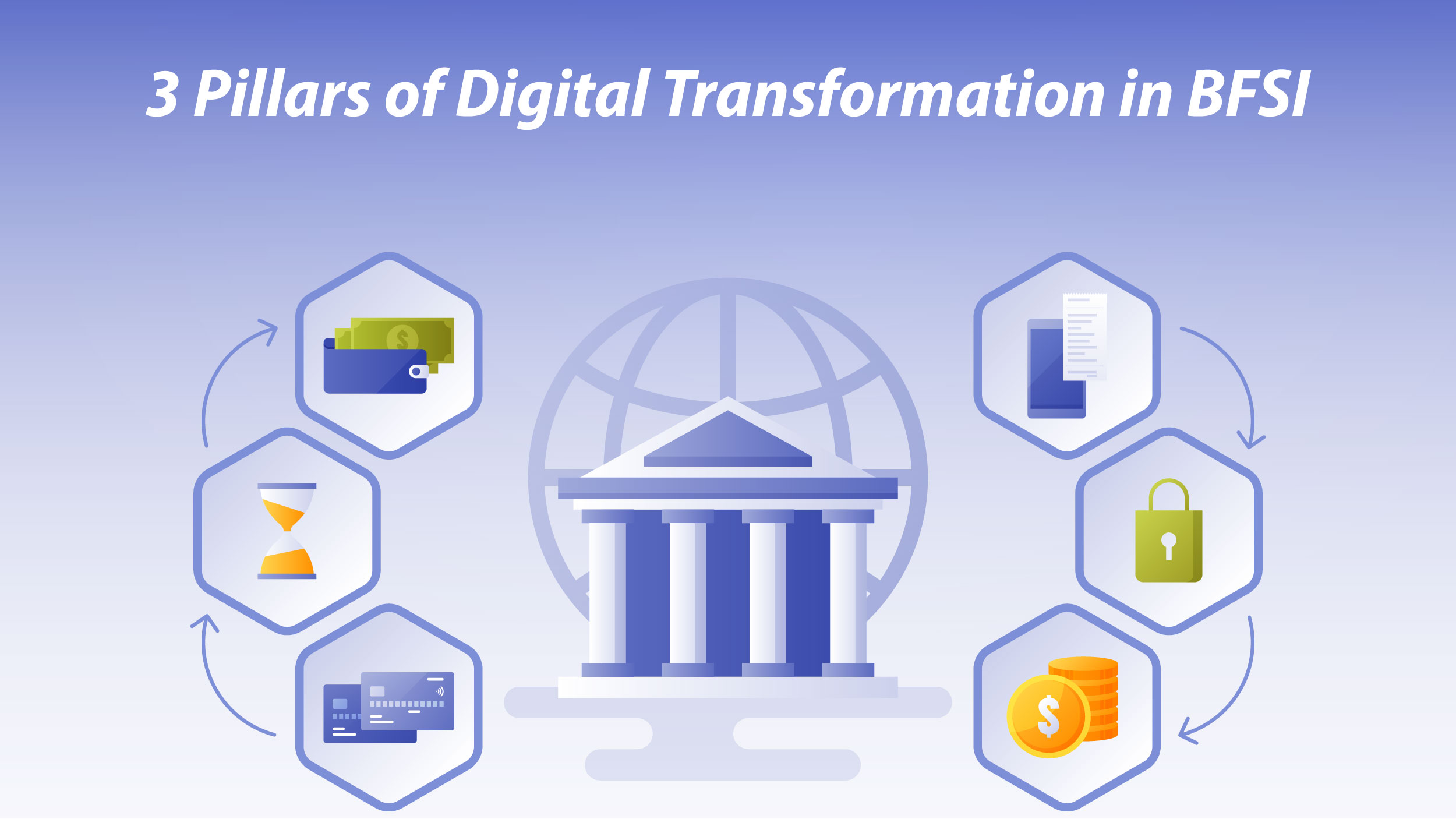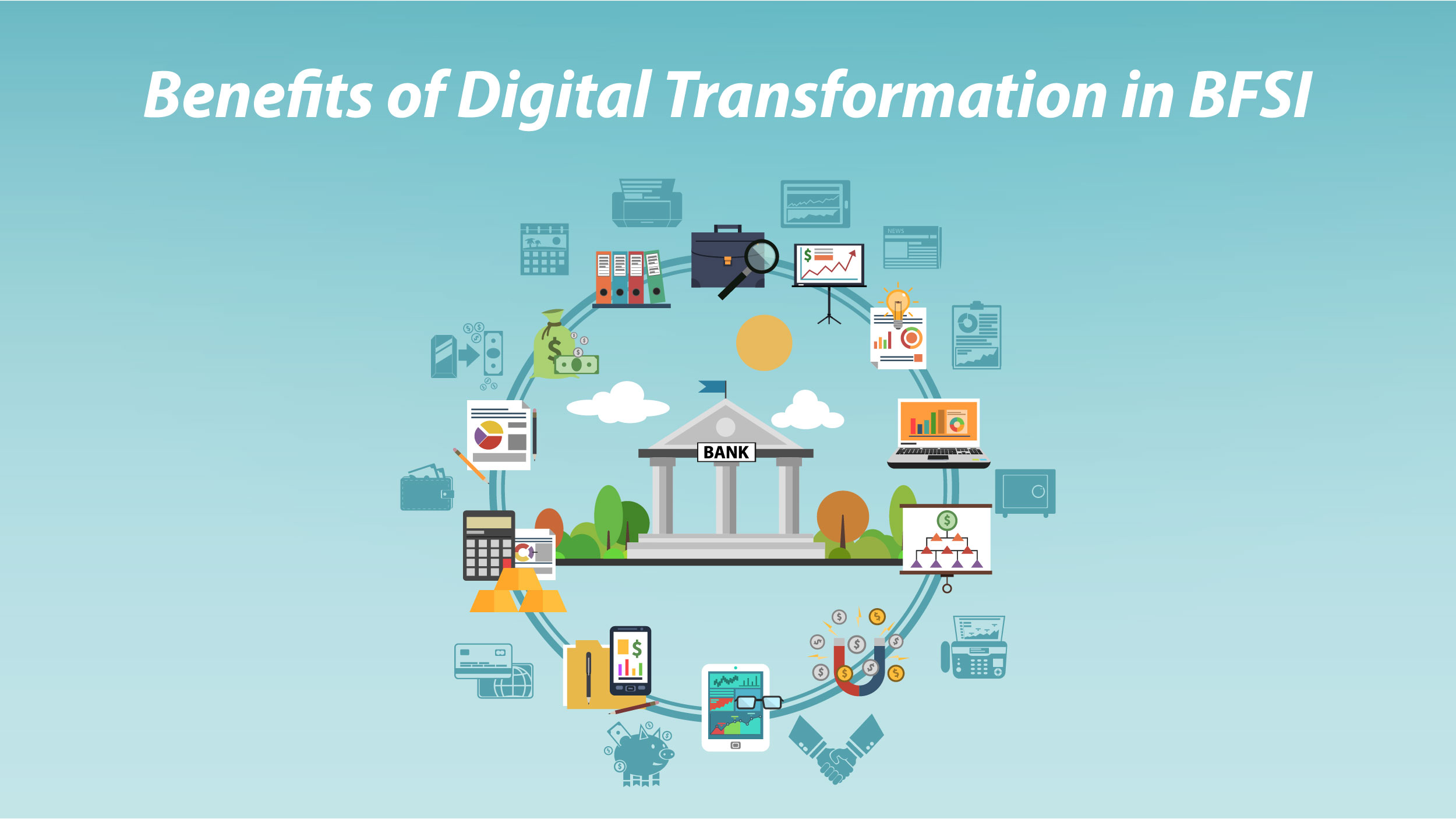In the rapidly evolving landscape of Banking, Financial Services, and Insurance (BFSI), one term has become the cornerstone of innovation and progress: digital transformation. This dynamic shift towards leveraging cutting-edge technology is reshaping how financial institutions operate, interact with customers, and stay ahead in an increasingly competitive market. From streamlining operations to revolutionizing customer experiences, the impact of digital transformation in BFSI is nothing short of revolutionary.
Let’s talk more about the digital transformation in BFSI and cover everything about it in this comprehensive guide.
What is Digital Transformation in BFSI?
Digital transformation in BFSI encompasses three crucial phases: digitization, digitalization, and full-fledged digital transformation. The journey began with digitization in the late 70s and early 80s, focusing on safeguarding physical data by converting it into electronic format. Although initially, consumers didn’t see significant benefits, their data was securely stored. Digitalization followed, leveraging digital technologies to revamp business models, creating new avenues for revenue and value-added services.
With the turn of the millennium, the BFSI sector saw remarkable growth in digitalization, offering consumers simplified, efficient, and time-saving transactions. In recent years, digital transformation has revolutionized consumer interactions with financial institutions, allowing operations from anywhere in the world. Processes once time-consuming are now seamless and expedited, benefiting both the industry and end-users alike. Today, accessing cash is as simple as walking into any bank’s ATM.
3 Pillars of Digital Transformation in BFSI

Successful digital transformation in the banking sector rests on the following pillars:
1. Reinventing Consumer Experience
Banks strive for seamless consumer experiences, meeting basic expectations. They pinpoint critical stages based on diverse consumer needs, ultimately digitizing the process for enhanced service and freeing up staff for higher-level tasks. Researching transaction history helps identify pivotal points for improvement, significantly impacting the overall business.
2. Leveraging Data Analytics
Financial institutions leverage data for insights, cost-cutting, and risk prediction. For example, granular cluster analytics enables product comparison and effective customer relationship management. Data mining refines customer targeting, identifies pricing discrepancies, and assesses loyalty for enhanced retention.
3. Building a New Operating Model
To meet consumer demands, banks must balance digital convenience with human support for complex services. There are three operational models for digital banking:
- Business-as-usual: Incremental digitization efforts, cost-effective, low risk. Ideal for early transformation stages.
- New business: Establishes a dedicated team for digital processes, enhancing customer experience and accountability. More complex, suited for mid-to-advanced transformation stages.
- Digital native: Creates a new digital bank with a dedicated technology stack, prioritizing customer recruitment and rapid impact. Challenging to migrate existing customers. Suited for highly advanced digital transformation stages.
Benefits of Digital Transformation in BFSI

Digital transformation in BFSI offers a multitude of benefits:
● Time and Money
A consumer-centric digital approach has been working for the banks. It has helped reduce transaction durations and transformed moribund banks into consumer-friendly entities. Mobile banking has proven to be a game changer. Transactions on net banking have revolutionized commerce and driven digitization.
● Customer Retention
Digitization has eliminated several primary banking hassles. Gen Z and Millenials prefer on-screen customer service for its ease of use, which further propels rapid digitization in the industry.
As a great chunk of consumer service has gone digital, customer retention has grown substantially. The cohesive pipeline created due to a digital experience allows customers to decide their experience enabling targeted marketing.
Several banks have gone a step further and introduced digital investment options.
For instance, Merril by Bank of America has introduced investment options that allow the user to invest their money within minutes without even stepping into their brick-and-mortar branches.
● Tech and BFSI
Technology-centricity is creating waves in the industry. Consumer behavior prediction, pattern recognition, fraud detection, risk management, and much more have been enabled on a greater scale as these technologies continue to empower financial organizations.
Analytics allow for customized and targeted marketing. This has substantially improved revenue generation. Moreover, several banks are integrating technology just to save time.
For instance, lawyers and bankers at JP Morgan Chase & Co. used to spend an average of 360,000 hours on mundane financial tasks. An AI algorithm successfully completed the same task within minutes, which resulted in huge savings of time and money.
In a similar context, the introduction of chatbots and AI has been leveraged by several financial organizations such as JP Morgan. Herein, several processes such as account creation, deposits and withdrawals, loan processing, and investments are done digitally.
● Digital First Approach
Several financial organizations have become digital-first by approach. This is not only to be resilient in the industry but also to continue serving customers 24×7.
Such a scenario is a goal for many, and yet digitization requires high levels of consistency. The sheer amount of investment for such a transformation is staggering, to say the least. Also, legislation, security issues, and stringent frameworks for data privacy are some of the challenges that impede the digital transformation efforts of the industry.
In such a situation, highly qualified bankers, skilled technicians, and consistent quality of service are going to prove detrimental to the organization’s success.
Digital Transformation in BFSI: Regulatory Compliance
Banks and financial organizations, due to their handling of sensitive customer data, must adhere to stringent data, security, and privacy regulations, which include:
- Title V of the Gramm-Leach-Bliley Act: Mandates financial institutions to safeguard the confidentiality and security of customers’ nonpublic personal information.
- PCI DSS (Payment Card Industry Data Security Standard): Applies to all corporate entities that handle cardholder data, necessitating secure storage, processing, and transmission.
- GDPR (General Data Protection Regulation): Regulates the collection and protection of personal data by corporate entities operating within the EU or gathering information from EU residents.
Concluding Thoughts
As the winds of change continue to sweep through the BFSI sector, embracing digital transformation isn’t just an option—it’s a strategic imperative. The journey involves adapting to new technologies, reimagining customer interactions, and staying agile in a rapidly evolving landscape. By harnessing the power of digital tools and technologies, financial institutions are not only future-proofing their operations but also ensuring that they remain at the forefront of an industry that is destined for continuous innovation and growth. The era of digital transformation in BFSI is here, and those who seize its potential are poised to lead the way into a future of limitless possibilities.




